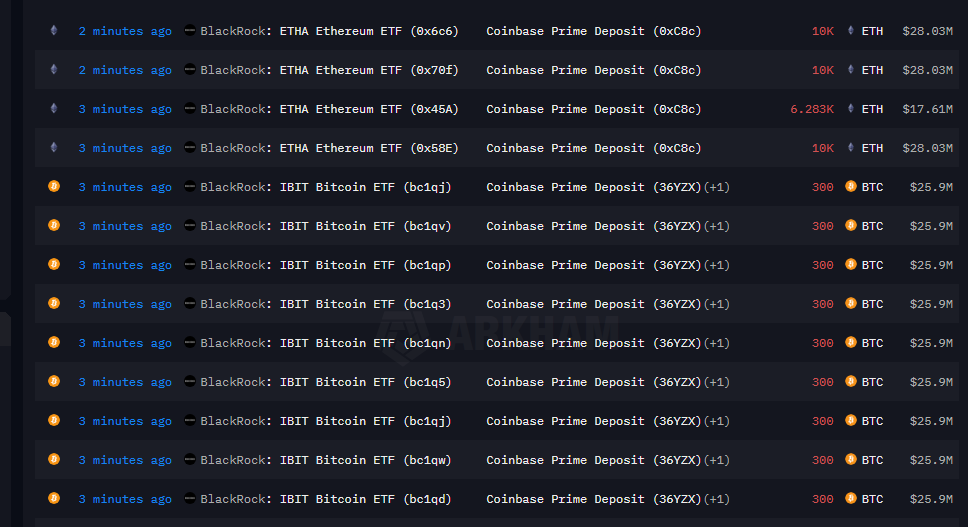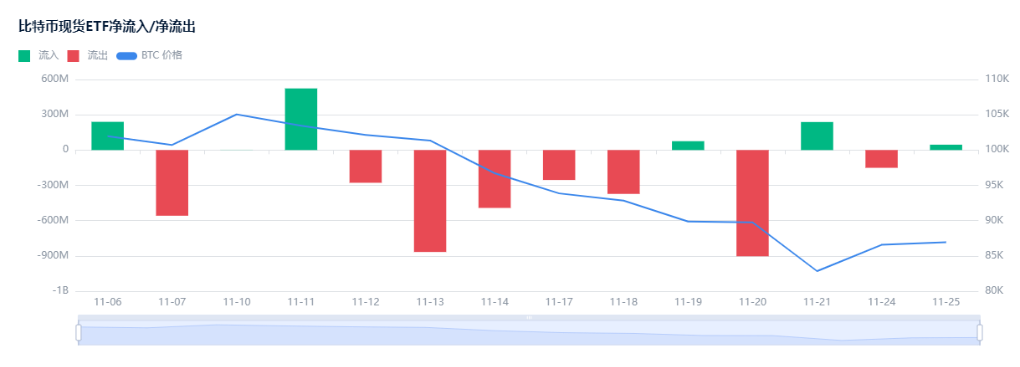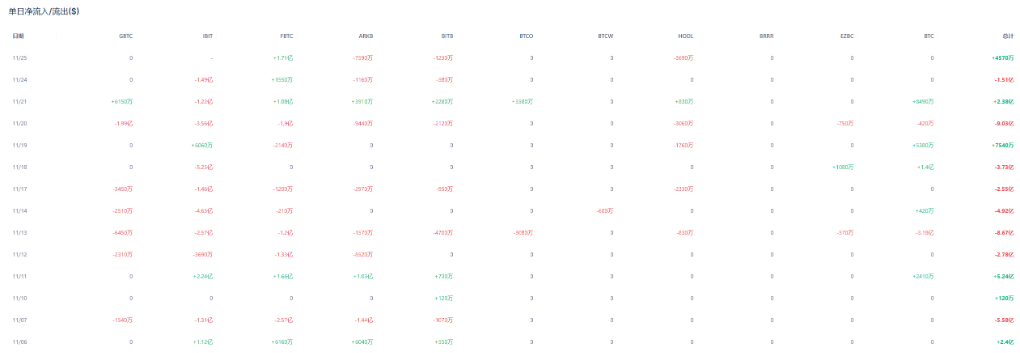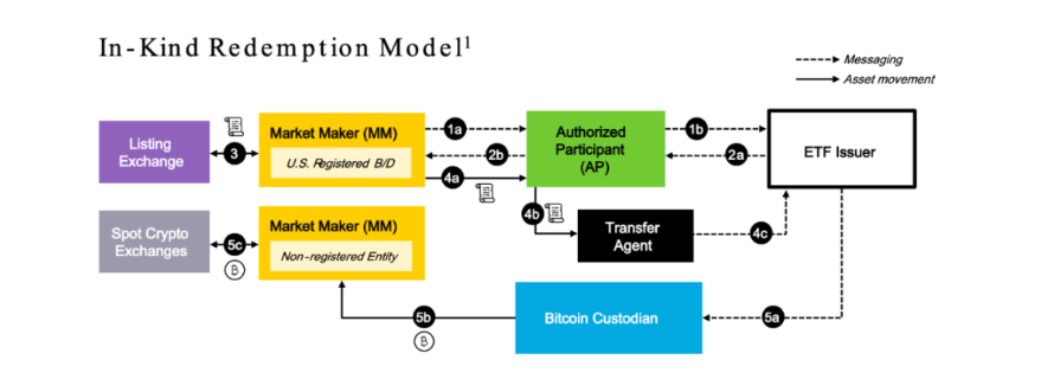On-chain data flashed massive bitcoin transfers from BlackRock to exchanges, sending shockwaves through the market, yet few realized this was the end of the sell-off, not the beginning.
Recently, a series of large bitcoin transfers from BlackRock to Coinbase have attracted widespread attention from cryptocurrency investors, with many interpreting them directly as signals of institutional dumping. Wintermute founder Evgeny Gaevoy pointed out incisively that this is actually a highly lagging indicator.
The real selling already took place in the ETF market; the on-chain transfer is merely the final step in the entire process.

I. Market Misinterpretation: Panic Triggered by Lagging Indicators
● The market’s misreading of BlackRock’s large transfers stems from a lack of understanding of ETF operational mechanisms. The so-called “BlackRock large transfer” specifically refers to transfers of cryptocurrency from BlackRock’s spot bitcoin ETF (IBIT) reserve address to the Coinbase Prime custody address.
● The transfer is actually a step in the process where large market makers conduct market making and hedging around the ETF when there is a net outflow from the ETF.
● When investors see on-chain transfers, they often interpret this as a signal that institutions are about to sell, not realizing that the real market selling pressure has already occurred. This misunderstanding causes investors to make irrational decisions during market volatility, exacerbating market panic.

● Since November, investors have withdrawn 3.5 billions USD from bitcoin ETFs, nearly matching the record monthly outflow of 3.6 billions USD set in February. Of this, BlackRock’s bitcoin ETF (IBIT) has seen redemptions of 2.2 billions USD this month alone, and unless there is a dramatic reversal, it will mark its worst monthly performance ever.

II. Operational Mechanism: Decoding the Full ETF Redemption Process
To understand BlackRock’s operational mechanism, we need to delve into the complete process when an ETF experiences net outflows.
Cash Redemption Model
● BlackRock ultimately adopted a “cash creation” model for its bitcoin ETF redemptions, in line with the stance of US financial regulators. Under the “cash only” redemption mechanism, investors wishing to redeem their ETF shares must use cash.
● BlackRock will sell bitcoin and distribute cash to redeeming shareholders. This approach eliminates the possibility of participants directly exchanging bitcoin for ETF shares.
Redemption Process
● Market makers buy ETF shares from ETF sellers and then submit redemption requests to BlackRock, exchanging ETF shares for BTC. This process typically has a 1-day delay.
● The key point is that market makers simultaneously complete hedging operations when purchasing ETF shares, i.e., selling an equivalent amount of cryptocurrency in the external market.
● Gaevoy explained: “The real selling pressure does not occur when retail investors see the on-chain transfer, but rather when market makers are taking ETF sell orders and simultaneously selling to hedge in the external market.” Since the redemption process usually has a 1-day delay, the actual selling pressure may have occurred a day earlier.
● Specifically, in the cash/USD model, the redemption process is as follows: market makers first repurchase ETF shares from the US stock market, sell BTC in the crypto market (the recovered USD is immediately handed over to the cash custodian). The next day (T+1), the market maker and TA settle: the market maker hands over the repurchased ETF shares to TA, and TA returns the USD to the market maker.
III. Model Differences: Why the SEC Insists on the Cash Model
When it comes to the choice of ETF creation and redemption models, BlackRock initially preferred the physical model, but the US Securities and Exchange Commission (SEC) insisted on the use of the cash model.
● The physical model (also known as the BTC model) directly links ETF shares to the amount of BTC; redeeming ETF shares means selling an equivalent amount of BTC. This is a very straightforward and simple model. Under the physical/BTC model, ETF issuers only need to manage the correspondence and accounting between ETF shares and BTC, without worrying about the constantly fluctuating USD price in the market.

● The cash model (also known as the USD model) converts ETF shares into the corresponding amount of BTC via USD; to redeem ETF shares, they must first be converted into USD, and then USD is converted into BTC.

● The SEC prefers the cash/USD model because, first, it isolates the risks of the two markets for easier separate regulation; second, it ensures the dominant role of the USD as the pricing currency; and third, it facilitates taxation of participating entities.
For end-market investors, there is not much perceived difference between the two schemes. ETF investors in the US stock market buy ETFs with USD and receive USD when selling ETFs.
IV. Market Impact: Capital Outflows and Price Volatility
The bitcoin ETF market is experiencing significant capital outflows, which have already had a substantial impact on bitcoin prices.
● Data shows that US-listed bitcoin ETFs are experiencing the worst monthly capital outflows in nearly two years. This not only puts greater pressure on an already weak cryptocurrency market but also reshapes the way capital flows into and out of this asset class.
● Since their launch in January 2024, spot bitcoin ETFs have become a barometer of sentiment in the cryptocurrency market, creating a self-reinforcing feedback loop: capital inflows accelerate when prices rise, and outflows intensify when prices fall.
● The Citi research team quantified this phenomenon: for every 1 billion USD outflow from bitcoin ETFs, the price drops by an average of 3.4%, and vice versa. Citi analyst Alex Saunders said this mechanism explains bitcoin’s recent pullback.
● Bitcoin’s price fell to 80,553 USD over the past weekend. Although it rebounded slightly over the weekend, as of November 24, the cryptocurrency was trading at 86,020 USD, with a cumulative decline of 8% for the year.
● From a broader financial market perspective, all types of high-risk assets, from AI concept stocks and meme stocks to high-volatility momentum trades, have seen pullbacks. The S&P 500 is experiencing its worst monthly performance since March, and at the beginning of this month, the short-term correlation between bitcoin and tech stocks hit a record high.
V. The Role of Market Makers: Risk Transfer and Market Stability
In the operation of bitcoin ETFs, market makers play a key role. BlackRock plans to transfer risk to crypto market makers after its spot bitcoin ETF is approved, making it easier for Wall Street banks to participate.
● The plan includes an innovative method for redeeming ETF shares. Under the cash/USD creation model, USD separates the two markets. Market makers act more like “tools,” simply trading ETF shares/USD and BTC/USD in the two markets independently.
● If arbitrage or losses occur due to time differences between operations in the two markets or price differences between markets, under the cash model, market makers do not have to bear such inter-market risk.
● The revised model addresses a key gap. BlackRock did not specify the exact method but stated that the new process provides “superior resistance to market manipulation,” reflecting the SEC’s main concern about the product.
● Allowing large institutions (which manage tens of billions of dollars in assets for clients) to redeem shares faster and with lower risk could mean more institutional capital flowing into spot bitcoin ETFs.
VI. Investment Insights: Focus on the Right Indicators and Long-Term Trends
For rational investors, understanding BlackRock’s operational mechanism is directly meaningful for correctly interpreting market signals.
● Investors should pay more attention to daily ETF inflow and outflow data, which are the real-time indicators reflecting market capital movements. On-chain transfers are merely the settlement step in the standard ETF operation process, and the selling pressure they represent usually appears before the transfer, not after.
● Relevant data is also more clearly and comprehensively presented in daily ETF inflow and outflow monitoring, so there is no need to interpret it as an additional bearish signal, which could cause unnecessary panic.
● When there is a net inflow into ETFs, market makers also sell ETFs to buyers while buying cryptocurrency and sending it to the ETF issuer. Although there is no redemption time limit here, so the lag time is shorter, there is still some delay.
● Nick Ruck, Director at LVRG Research, pointed out: “The outflows from IBIT confirm that the market’s frenzy at the beginning of the year has been exhausted.” This understanding helps investors view market cycles from a more macro perspective, rather than overreacting to every on-chain transfer data point.

BlackRock’s bitcoin ETF has become one of the most important institutional holders of bitcoin in the market. Its capital flows have a profound impact on market sentiment, but understanding the essence of this mechanism is crucial. When the market sees on-chain data of BlackRock transferring to exchanges again, it should be understood that this is merely the finale of a massive operational mechanism, not the beginning.